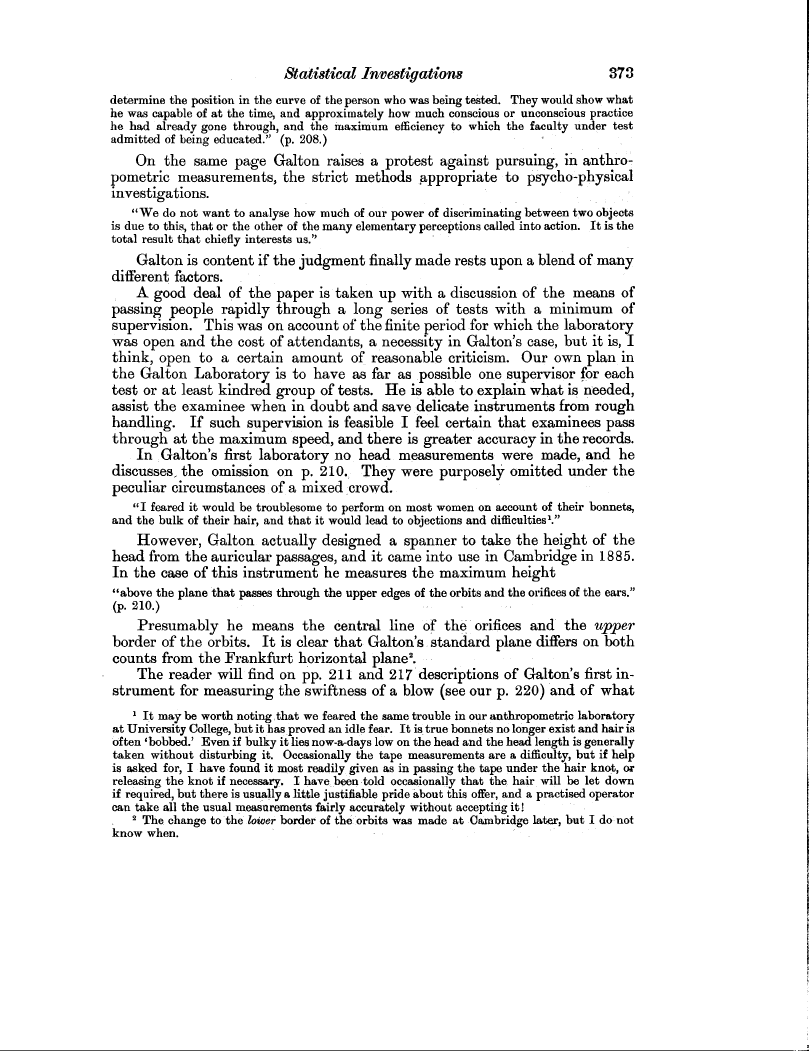Statistical Investigations 373
determine the position in the curve of the person who was being tested. They would show what he was capable of at the time, and approximately how much conscious or unconscious practice he had already gone through, and the maximum efficiency to which the faculty under test
admitted of being educated." (p. 208.)
On the same page Galton raises a protest against pursuing, in anthropometric measurements, the strict methods appropriate to psycho-physical investigations.
"We do not want to analyse how much of our power of discriminating between two objects is due to this, that or the other of the many elementary perceptions called into action. It is the total result that chiefly interests us."
Galton is content if the judgment finally made rests upon a blend of many different factors.
A good deal of the paper is taken up with a discussion of the means of passing people rapidly through a long series of tests with a minimum of supervision. This was on account of the finite period for which the laboratory was open and the cost of attendants, a necessity in Galton's case, but it is, I think, open to a certain amount of reasonable criticism. Our own plan in the Galton Laboratory is to have as far as possible one supervisor for each test or at least kindred group of tests. He is able to explain what is needed, assist the examinee when in doubt and save delicate instruments from rough handling. If such supervision is feasible I feel certain that examinees pass through at the maximum speed, and there is greater accuracy in the records.
In Galton's first laboratory no head measurements were made, and he discusses, the omission on p. 210.: They were purposely omitted under the peculiar circumstances of a mixed crowd.
"I feared it would be troublesome to perform on most women on account of their bonnets, and the bulk of their hair, and that it would lead to objections and difficulties'."
However, Galton actually designed a spanner to take the height of the head from the auricular passages, and it came into use in Cambridge in 1885. In the case of this instrument he measures the maximum height
"above the plane that passes through the upper edges of the orbits and the orifices of the ears." (p. 210.)
Presumably he means the central line of the orifices and the upper border of the orbits. It is clear that Galton's standard plane differs on both
counts from the Frankfurt horizontal plane'.
The reader will find on pp. 211 and 217. descriptions of Galton's first in
strument for measuring the swiftness of a blow (see our p. 220) and of what
' It may be worth noting, that we feared the same trouble in our anthropometric laboratory at University College, but it has proved an idle fear. It is true bonnets no longer exist and hair is often 'bobbed.' Even if bulky it lies now-a-days low on the head and the head length is generally taken without disturbing it. Occasionally the tape measurements are a difficulty, but if help is asked for, I have found it most readily given as in passing the tape under the hair knot, or releasing the knot if necessary. I have been told occasionally that the hair will be let down if required, but there is usually a little justifiable pride about this offer, and a practised operator can take all the usual measurements fairly accurately without accepting it.
2 The change to the lower border of the orbits was made at Cambridge later, but I do not know when.

